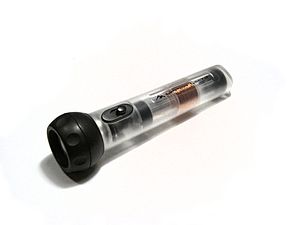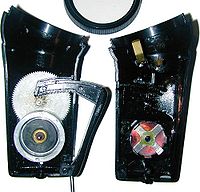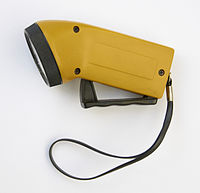- Mechanically-powered flashlight
-
A mechanically powered flashlight is one of several varieties of flashlight that are powered by electricity generated by the muscle power of the user, so they do not need replacement of batteries, or recharging from an electrical source. The light source can be a miniature incandescent bulb, or a light-emitting diode.
Different mechanical motions are used to generate the required power, such as squeezing a handle, winding a crank, or turning or shaking the device itself. These flashlights can also be distinguished by the technique used to store the energy: a spring[1], a flywheel, a battery or a capacitor.
A well-designed, well-made mechanical flashlight can be a reliable, robust tool for providing light in emergency situations. However, poor-quality and outright fake mechanical flashlights have been widely sold, tarnishing the reputation of the product category.
Contents
Dyno torch
A dyno torch is a flashlight or pocket torch which stores energy in a flywheel. The user repeatedly squeezes a handle to spin a flywheel attached to a small dynamo, supplying electrical current to an incandescent bulb or light-emitting diode. Because electrical power is produced only when the handle is squeezed, a switch is not needed. The flywheel makes sure the light is fairly constant, despite the fact that the power supply (the squeezing) is intermittent. Dyno torches were very popular in Europe during World War II[citation needed] because the electrical power supply to homes was not very reliable.
In an alternative design, the dynamo charges a rechargeable battery or a capacitor, and may offer 15 minutes or more of illumination for 1 minute of charging.[citation needed] However, this version could be considered less reliable for emergency use because the battery will eventually fail and need replacement.
Dyno torch design
In the photo, the L-shaped handle has a gear rack, which spins the white step-up gear, which in turn spins the flywheel on which is mounted the dark grey magnet, seen on the lower left. The magnet induces an electrical current in the red copper winding, seen on the lower right. The current from the copper winding flows through an incandescent bulb filament (not shown). A spring and ratchet returns the handle to its original position after each engagement.
Shake type design
The linear induction or "shake flashlight" is another design of a mechanically-powered flashlight. It was sold in the US via direct marketing campaigns beginning in 2002.
This design contains a linear electrical generator which charges a capacitor when the flashlight is shaken lengthwise. The battery or capacitor powers a high-intensity white LED or LED array. In the linear generator, a sliding rare earth magnet moves back and forth through a solenoid, a spool of copper wire. A current is induced in the loops of wire by Faraday's law of induction each time the magnet slides through, which is used to charge the capacitor.
In the best designs, vigorously shaking the light for about thirty seconds may provide up to five minutes of light, though only the first 2 or 3 minutes are very useful. Shaking the unit for 10 to 15 seconds every 2 or 3 minutes as necessary permits the device to be used continuously. An ultra-capacitor is used instead of a rechargeable battery since it doesn't wear out like a battery.
Note that fraudulent counterfeit versions of these flashlights have been sold, most of which incorporate thin lithium cells "hidden in plain sight." In some of those, the "magnet" is not a magnet (or the coil is not connected) and no electricity is generated when the device is shaken. These fraudulent flashlights eventually become useless, since their internal batteries cannot be recharged or replaced, and the case is often permanently glued shut.[2][3]
Other functions
Some mechanically powered flashlights include other functions and features beyond just a source of light. For example, certain models may have additional special operating modes, such as flashing red or yellow lights that can serve as a caution or warning to other people that might see the light. Some models include a loud electronic siren that can also help warn of danger, or assist in locating someone who is lost. There are also many models of mechanically powered flashlights that include a built-in AM/FM, weather or shortwave radio.
The quality and long-term reliability of these devices vary over a wide range, from high-reliability mil-spec emergency equipment down to one-time-use non-repairable throwaways.
See also
References
- ^ Tiny Dynamo Operates New Batteryless Flashlight, Popular Science, February 1929 page 74
- ^ "Fakes, Frauds, and Fallacies: Products to Avoid!". flashlightreviews.com. http://www.flashlightreviews.com/features/fff.htm. Retrieved 2011-08-15.
- ^ "Shake Flashlights FAQ". Shake Flashlights Info. Shake-Flashlights.com. http://www.shake-flashlights.com/faq.html. Retrieved 2011-08-15.
External links
- ElectronicCrafts.org: Homemade shakelight
- Instructables: A homemade solenoid type dyno torch inside a TicTac box.
- Die Goldcap-Dynamolampe (in German) — converting a dyno torch to LED operation with capacitor storage
Categories:
Wikimedia Foundation. 2010.




